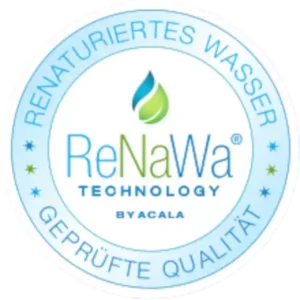ReNaWa®- Technology

Exploring the invisible. ReNaWa® technology is based on the conviction that water is more than just a chemical compound of hydrogen and oxygen. It is a living element that is capable of storing and transmitting information. The structure and quality of the water we consume has a direct impact on our health and well-being.
By converting industrial water into structured water of spring water quality, a process is set in motion that restores the natural properties of the water. This process involves several steps:
1st **Relaxation**: Here, the water is calmed in a special process to promote the natural structure and reduce the stress caused by mechanical processing.
2. purification**: In this step, unwanted substances and impurities that may be present in the water are removed. This is done not only by physical filtration, but also by innovative technologies that take into account the energetic properties of the water.
3. treatment: Finally, the water is treated so that it regains its original, natural structure. This is done using special processes that revitalize the energetic and biological properties of the water.
The result is water that is not only clear and pure, but also lively and tasty. It is reminiscent of water from pristine springs and provides the body with the support it needs to stay healthy and vital.
ReNaWa® technology is a response to the challenges posed by modern water. It reconnects us with nature and promotes a conscious, healthy lifestyle. By learning to listen to our instincts again and consuming water that is close to nature, we can sustainably improve our health and increase our well-being.
In a world where water is often taken for granted, ReNaWa® invites us to regain an appreciation for this precious commodity and discover the benefits of high-quality, structured water. It’s time to rethink our relationship with water and harness the power of nature for our health.
Observing nature and its structures often reveals deeper insights that are not immediately apparent at first glance. The diversity and elaborate construction of natural elements – from trees to blades of grass to bees – are an expression of an overarching design that runs through all forms of life. This insight leads us to another fascinating element of nature: water.
Water, with its unique crystal structure, is not only a vital element, but also an excellent solvent. This property is both a blessing and a curse. While water transports nutrients and minerals, it can also absorb unwanted substances that we don’t want in our bodies. Water’s ability to bind with various substances makes it an indispensable part of life, but it also carries risks.
Another crucial aspect is the constant movement of the water. This dynamic is not just a physical phenomenon, but also has a profound effect on the quality and purity of the water. In ReNaWa® technology, this natural movement of water is seen as the key to obtaining pure spring water. By imitating and supporting this movement, we can improve the quality of the water and rid it of harmful substances.
Overall, it turns out that the simplest observations in nature often provide the most complex and profound insights. Water, in its movement and structure, is a perfect example of how, by looking closely and understanding the laws of nature, we can not only better understand the world around us, but also find innovative solutions to current challenges.
Where is the quality of our tap water actually lost?
Drinking water ordinance with high limit values
In Switzerland, there are increasing concerns about the limit values for pollutants in drinking water. Despite strict monitoring, these values are constantly being raised, which calls into question the safety of consumers. The adjustments are often made under the pretext of taking new scientific findings into account, but many citizens feel unsettled as a result. Pollutants such as pesticides, hormones and drug residues end up in the water supply and pose a health risk. The current limit values hardly give consumers any confidence in the quality of drinking water.
The journey of tap water
The journey of tap water through the pipes is an unnatural experience for water. In the wild, water moves in a constant cycle, finding its own way through soils, rivers and streams where it comes into contact with minerals and organic matter. This natural movement promotes the healthy molecular structure of water. However, when it is channeled through the often narrow, artificial pipes, this process is disrupted. The pressure and rigid walls of the pipes can affect the molecular structure of the water and alter its energetic properties. Water that flows harmoniously in nature is forced to move in unnatural directions in the pipes, leading to a decrease in its vitality. This unnatural journey impairs the quality of the water and alienates it from its original purity.
Additives in tap water
The treatment of drinking water is an important process to ensure safety and hygiene. Chemical additives such as chlorine are often used to kill bacteria and other microorganisms. While these disinfectants are effective in fighting germs, they also have undesirable side effects. Chlorine can affect the taste of the water and lead to an unpleasant odor. It also affects the molecular structure of the water, which changes its energetic properties.
These changes can be harmful to the consumer's health as they can reduce the bioavailability of minerals and nutrients in the water. In the long term, the consumption of chlorinated water, for example, could also lead to undesirable reactions in the body. Many people are unaware of the effects of these chemical additives and consume water on a daily basis that is not only treated but also impaired in its natural purity.
The dilemma of our tap water
The above points lead the water into a degenerate state. It may still look the same to our human eyes, but in reality it has been changed.
Different sources of our drinking water, the length of the journey it has to take to reach our taps and the additives that are added ultimately determine the quality or lack of quality of our tap water. It usually has little in common with spring water.
How Acala gives quality back to tap water.
Low limit values
Acala is not satisfied with the high limit values. Our aim is to restore the original purity of drinking water. With our filters, we strive to remove almost 100% of the pollutants.
The pollution of our drinking water is caused by us humans with our economy and often what we call progress.
A clever interplay of several components makes it possible to remove the burden of contaminated tap water step by step or drip by drip.
The ceramic does the preparatory work and removes particles from the water, which are often even visible in the retained quantity.
However, the big star of the discharge is the highly conductive activated carbon made from coconut shells. It retains enormous quantities of unwanted substances on its large surface. Such unwanted substances include lead, mercury, uranium, aluminum, hormones, chlorine, etc.
An additional protective layer is provided by zeolite, a mineral obtained by grinding natural volcanic rock. It acts as an extremely fine filter system. Due to its special negatively charged crystal structure and enormous inner surface area - which can be up to 1000 m² at just one gram - this rock is able to effectively filter harmful, positively charged particles such as heavy metals and radioactive substances from the water.
Wellness for water
The ceramic pre-filter ensures optimum wellness for water by loosening up the dense accumulations of water molecules. This allows the water to recover from the high pressure in the pipes and flow in a gentle, natural flow. The water can move independently, from top to bottom, and only passes through the various filter stages under its own weight. In nature, mountains, soil and plants act as natural pre-filters. In ReNaWa® technology, this process is simulated by our fine-pored ceramic filter. This filter ensures that coarse impurities such as bacteria are effectively removed, as its pores are only between 0.2 and 0.45 micrometers in size - around 250 times the thickness of a human hair. This improves the water quality in a natural way and contributes to a healthy drinking experience
Enrichments for drinking water
After the tap water has been purified using ceramic and activated carbon, it is now structurally rebuilt and enriched.
Bioceramic beads release calcium ions into the passing water. This shifts the water's pH value into the alkaline range. Infrared rays from the environment are reflected by the ceramic beads and thus promote the reabsorption of the hexagonal structure on a molecular level.
The hopeful way out
Fresh spring water is a real treat - it tastes refreshing and delicious, while at the same time revitalizing and doing the body good. In nature, the water does not flow into a sterile container after it gurgles from the spring, but gently ripples through a natural stream bed filled with crystals, stones and gravel. This natural task is imitated by a layer of rock crystals, which gives the water a unique, original taste. The result is a drinking experience that is both refreshing and soothing.
Acala water filter systems are the way for our drinking water to recover, purify and enrich itself. The water also passes this information on to us. Recovery, purification, enrichment. Healthy water that makes us healthier.
